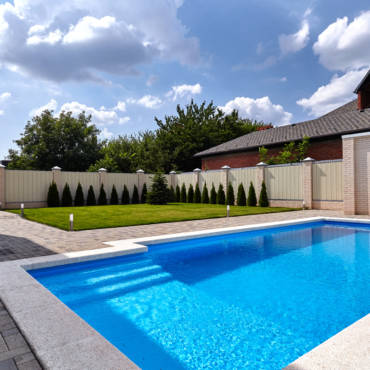Pool Maintenance for Beginners

One of the most satisfying ways to enjoy hot summer days is a swimming pool. However, like many of the most rewarding home luxuries, a pool also comes with the responsibility of proper care.
If you are a new pool owner or unsure of all the maintenance you should be performing, read our beginner’s guide below and start taking pride in a clean and well-cared for pool.
1. Skimming and Scrubbing
Skimming may seem like a no-brainer, but it can also be easy to fall behind on. Even if you have minimal to no trees in your yard, debris is still sure to find its way to your pool surface. For a perfectly clean pool, skimming should be done daily- or at least as often as possible.
You’ll also need to scrub the sides of your pool to remove any algae build-up. This task can be a bit harder than skimming, but thankfully does not need to be done nearly as often. To keep your pool pristine, you can plan on scrubbing every other week. For most of the pool, you may be able to get away with a rag or wash cloth. If you spot any trouble areas, you may need a scrub brush to totally remove the grime.
2. Clean the Filter
Thankfully you will have a lot of help keeping debris out of the pool in the form of your filter. When your filter is running efficiently, it will help to remove leaves, dirt, and other loose debris from the water. You may even find smaller pool toys in there from time to time.
Just like your HVAC, you will need to clean the filter regularly to keep it running smoothly. This can be done by turning off the filter, lifting the filter cap, and removing the filter basket inside. Then clean any dirt or debris before returning the basket and replacing the cap. Get in the habit of doing this once per week.
Your filter shouldn’t be running 24 hours per day- set it on a timer so that it runs at least 6 hours per day.
3. Clean the Pipes
In addition to the pool filter itself, you’ll also want to occasionally clean out the pipes that the filter utilizes. Your filter should have a setting that reads “backwash.” Once per month, clean the basket like normal and set the filter to backwash. Then turn on the pump and let it run until you see the waste pipe ejecting clear water. This will signal that the pipes have been cleaned out and that you can turn it off.
4. Become a Master Chemist
No, not seriously. But the chemical levels of your pool are one of the most important and most overlooked areas of maintenance. If your pool water is not balanced properly, it can appear murky, irritate your eyes or skin, and allow bacteria to flourish.
Believe it or not, there are five different chemical levels to concern yourself with:
- Chlorine– This is the most commonly known. Chlorine keeps your pool water free of germs. According to the CDC, the free chlorine concentration of your pool should be at least 1 ppm (parts per million).
- PH Level – There’s a good chance you’ve also heard of this one. The PH level of your pool concerns the acidity of the water. The PH level should be kept between 7.2 and 7.8 to help prevent irritation and keep the structure and equipment from eroding.
- Cyanuric Acid – Also known as a chlorine stabilizer, this protects chlorine from sunlight. If using this, the free chlorine concentration mentioned above should be at least 2 ppm.
- Total Alkalinity – This helps keep the PH level in balance. This level should be between 60-120.
- Calcium Hardness – If kept at proper levels, this will help prevent plaster damage if kept between 220 and 350. For pools with vinyl siding, you’ll want this kept at a lower level.
This may sound like a ton of information to process, but testing your water is easy. Go to your local pool supply store, or any large-size hardware retailer, to purchase a few testing kits. Fill the kit with a sample of your pool’s water, add the testing solution, and close the vials. After only a few seconds, you should have results- the water will change color, which you can compare to the chart provided with the kit. Adjust the chemical levels as needed until you find an acceptable balance.
To keep your water perfectly clear, with minimal odor, try to test your water once per week.
5. Monitor the Water Level
In addition to chemical levels, you’ll also need to keep an eye on the physical level of the water itself. This level will fluctuate with usage and after heavy rainfall.
Ideally, your water level should be about halfway up the pool filter. When the water level gets too low, simply grab your garden hose and fill it back up. When the water level gets too high, you’ll need a submergible pump from your local pool store or hardware store to help drain it.
It’s important to note that changing the water level will likely impact the chemical levels. So if you are resetting the water level, wait until after to check the chemical levels.
6. When Necessary, Shock It
Shocking a pool is something many people associate only with public swimming pools, and most of the time they would be correct. However, if you’ve just thrown a big pool party, or haven’t properly cleaned it for a while, you could have a significant bacteria buildup. When this happens, you’ll notice the water is a lot murkier than usual.
To “shock” a pool is to significantly raise the chlorine levels for a short period of time to kill a large amount of bacteria. To accomplish this, you’ll want to dilute 3-5 times the normal amount of chlorine with water, and slowly pour the solution into the pool’s return line. Let the solution slowly filter th roughout the pool, and then slowly refill the pool with clean water over time.
While you shouldn’t shock the pool too often, which could damage the siding, you shouldn’t be afraid to do it when necessary. You should expect to shock the pool at least twice every summer.




